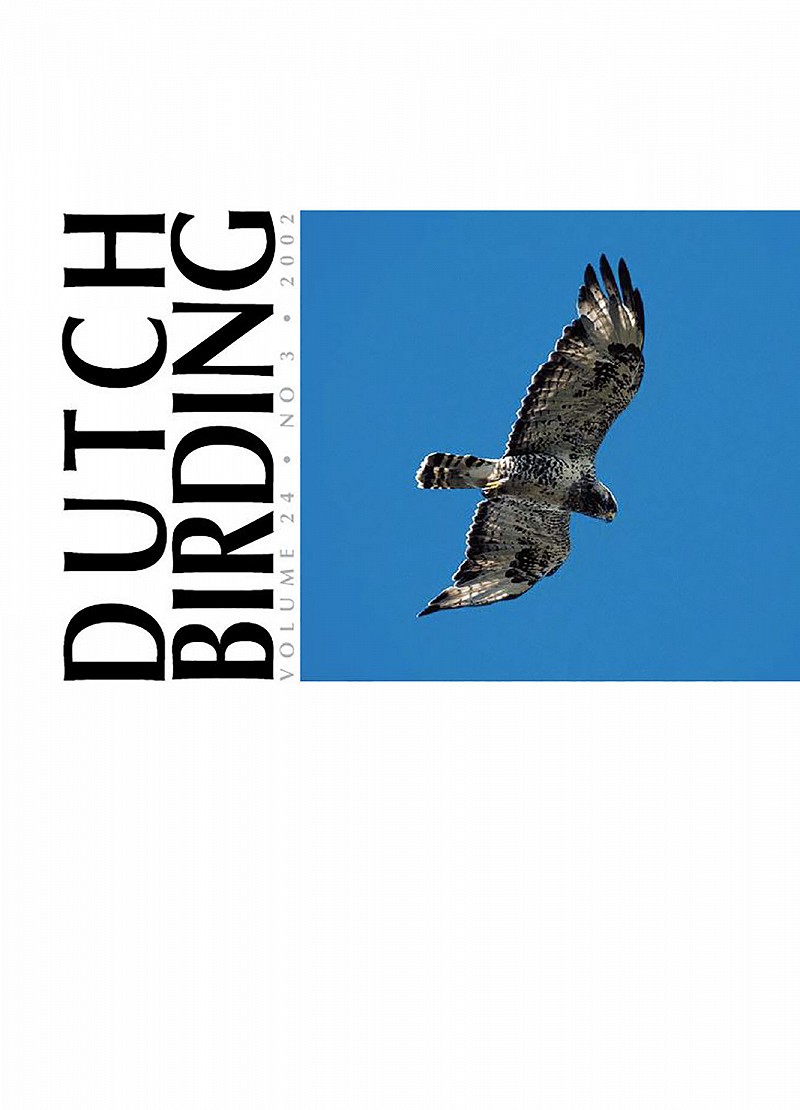Dutch Birding jaargang 24 nummer 3, 2002
VoorpaginaRuigpootbuizerd · Buteo lagopusChris Schenk |
|
Artikelen / papers | |
| 127 - 141 |
Birding in Burkina Faso, more than just birdwatching
Bruno Portier, Clark Lungren & Georges H Ouéda |
| 142 - 150 |
Hutchins\' Canadese Ganzen in Nederland / Hutchins\'s Canada Geese in the Netherlands
Max Berlijn & CDNA Hutchins\' Canadese Ganzen in Nederland / Hutchins\'s Canada Geese in the NetherlandsNa herziening van alle eerder aanvaarde gevallen van Hutchins\' Canadese Gans blijven vijf gevallen, alle uit 1997-98, staan op de Nederlandse lijst. Het is niet uitgesloten dat minder dan vijf verschillende vogels bij deze vijf gevallen betrokken waren. Hutchins\' Canadese Gans is het enige taxon van Kleine Canadese Gans op de Nederlandse lijst - bij andere taxa wordt een mogelijke wilde herkomst (vooralsnog) onwaarschijnlijk geacht. Alleen gevallen die aan de \'klassieke\' kenmerken van Hutchins\' Canadese Gans voldoen zijn aanvaard: formaat als Brandgans, korte hals, kleine snavel, roomwitte borst en lichte onderdelen, geen donkere keelstreep. Op basis van de revisie kan worden geconcludeerd dat dergelijke vogels daadwerkelijk zeldzaam zijn en dat het vaak lastig is om een Grote Canadese Gans van het taxon B c parvipes (Middelste Canadese Gans) of hybriden tussen verschillende taxa met zekerheid uit te sluiten. A review by the Dutch rarities committee (CDNA) of all records of Hutchins\'s (or Richardson\'s) Canada Goose Branta hutchinsii hutchinsii in the Netherlands has resulted in the deletion of five records, concerning 10 individuals. Five records remain, all of single birds in 1997-98 (9 March 1997, Anjum, Dongeradeel, Friesland; 16 November 1997 to 2 January 1998, Korendijkse Slikken, Korendijk and Stad aan \'t Haringvliet/Den Bommel, Middelharnis/Oostflakkee, Zuid-Holland; 9-12 February 1998, Aalkeetbuitenpolder, Vlaardingen, Zuid-Holland; 11-18 April 1998, Workumerwaard, Nijefurd, Friesland; and 24-26 April 1998, Bandpolder, Dongeradeel, Friesland, and 26 April 1998, Lauwersmeer, De Marne, Groningen). Some of these records may refer to the same individual. Hutchins\'s Canada Goose is the only taxon of Lesser Canada Goose B hutchinsii currently on the Dutch list; for the other taxa (Aleutian Canada Goose B h leucopareia, Cackling Canada Goose B h minima and Taverner\'s Canada Goose B h taverneri) a wild origin of birds recorded in Europe is, on current knowledge, considered impossible. The five remaining records all refer to birds showing the combination of \'classic\' hutchinsii characters: small size (similar to or smaller than Barnacle Goose B leucopsis) with relatively short neck and small triangular bill, pale brown underparts with even paler buffish-white breast and absence of dark chin-strap. Max Berlijn, Wilhelminastraat 9, 6285 AS Epen, Nederland |
| 151 - 155 |
Distribution and biology of Siberian Buff-bellied Pipit
Demetrius E Tae |
| 156 |
Spotted Sandpiper at Île de Gorée, Senegal, in February 2001
Tom M van der Have & Cornelie van der Hoop Spotted Sandpiper at Île de Gorée, Senegal, in February 2001On 20 February 2001 around 09:00, Cornelie van der Hoop observed and photographed a Spotted Sandpiper Actitis macularia at Île de Gorée, off Dakar, Senegal. The bird was foraging and resting on the rocky shoreline at the south-eastern side of the island. It foraged among several Ruddy Turnstones Arenaria interpres. SIZE & SHAPE Small wader resembling Common Sandpiper A hypoleucos, obviously smaller than nearby Turnstones. Impression \'heavy\' and robust. Steep forehead giving angled shape to head. Based on the white underparts, the bird was in winter plumage. The visible characters separating it from Common Sandpiper were the orange-yellow legs, toes and base of the bill, the stocky shape of the bird with a short (not visible) tail, the dark patch on the side of the breast, the clear white supercilium and the angled head (cf Svensson et al 1999). Tom M van der Have, Furkabaan 674, 3524 ZL Utrecht, Netherlands |
| 157 - 161 |
Brown Fish Owl in the Western Palearctic
Enno B Ebels |
Masters of mystery | |
| 162 - 164 |
Solutions of second round 2002: Bald Eagle and Solitary Sandpiper; Third round 2002
Rob van Bemmelen & Dick Groenendijk |
Corrigenda | |
| 165 |
Corrigenda
Redactie Dutch Birding |
Recensies / reviews | |
| 166 |
Woordenboek van de Limburgse dialecten, Deel III, Aflevering 1: Vogels door Joep Kruijsen & Woordenboek van de Brabantse dialecten, Deel III, Aflevering 1: Vogels door Jos Swanenberg
Klaas J Eigenhuis |
| 166 |
Birds of the Macaronesian Islands. Part 1: the Canary Islands & Madeira (Videocassette) by Leo J R Boon
Enno B Ebels |
| 167 |
Birds of Western Africa by Nik Borrow & Ron Demey
Laurens Steijn |
| 168 |
Threatened birds of Asia: The BirdLife International Red Data Book by A V Andreev, S Chan, N J Collar, M J Crosby, S Subramanya & J A Tobias (editors)
Frank G Rozendaal |
| 169 |
The Avifauna of Hong Kong by Geoff J Carey, Michael L Chalmers, David A Diskin, Peter R Kennerley, Paul J Leader, Michael R Leven, Richard W Lewthwaite, David S Melville, Michael Turnbull & Lew Young
Enno B Ebels |
Total Birding | |
| 170 - 171 |
Caution - humans ahead
Anthony McGeehan |
WP reports | |
| 172 - 180 |
March-May 2002
Arnoud B van den Berg |
Recente meldingen / recent reports | |
| 181 - 186 |
Nederland: maart-april 2002
Ruud M van Dongen, Klaas Haas & Peter W W de Rouw |
| 187 - 188 |
België: maart-april 2002
Gerald Driessens |
DB actueel | |
| 189 - 192 | Relationships of Dodo, Solitaire and Pink Pigeon; New species of antbird; Karel Voous 1920-2002; Alpengierzwaluw in Lauwersmeer - geen 1-aprilgrap [Alpine Swift]; Kleine Topper op vloeivelden van Groningen [Lesser Scaup]; Lammergier bekroont giereninflux [Lammergeier and Eurasian Griffon Vultures] |

